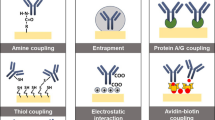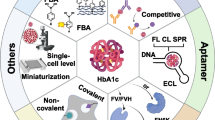Abstract
A new SPR sensing substrate was fabricated that is based on the use of graphene oxide (GO) and gold bipyramids (GBPs). It can substantially improve the sensitivity of wavelength modulation SPR biosensors. First, a support consisting of a sheet of single layered GO was prepared, and its morphology and thickness were determined by atomic force microscopy (AFM). GBPs were synthesized and modified with staphylococcal protein A (SPA) for the oriented immobilization of antibody. GBPs modified with SPA were assembled on GO sheets through covalent attachment. The resulting SPR biosensor exhibits a highly sensitive response to rabbit IgG in the 0.15–40 μg mL−1 concentration range. The limit of quantification is better by factors of 4 and 16 compared to those obtained with gold nanoparticle-based, and conventional gold film-based sensors, respectively. In our expectation, this GBP-based SPR biosensor has a wide scope in that it may be employed to develop detection schemes for many other biomolecules by changing the corresponding receptor on its surface.

A new sensing substrate based on graphene oxide and gold bipyramids was fabricated. The resulting SPR biosensor exhibits a sensitive response to rabbit IgG.






Similar content being viewed by others
References
Feng LY, Wu L, Qu XG (2013) New horizons for diagnostics and therapeutic applications of graphene and graphene oxide. Adv Mater 25:168–186
Hummers WS, Offeman RE (1958) Preparation of graphitic oxide. J Am Chem Soc 80:1339
Eda G, Chhowalla M (2010) Chemically derived graphene oxide: towards large-area thin-film electronics and optoelectronics. Adv Mater 22:2392–2415
Li XL, Zhan GY, Bai XD, Sun XM, Wang XR, Wang EG, Dai HJ (2008) Highly conducting graphene sheets and Langmuir–Blodgett films. Nat Nanotechnol 3:538–542
Kim F, Cote LJ, Huang JX (2010) Graphene oxide: surface activity and two-dimensional assembly. Adv Mater 22:1954–1958
Tian J, Yuan PX, Shan D, Ding SN, Zhang XT (2014) Biosensing platform based on graphene oxide via self-assembly induced by synergic interactions. Anal Biochem 460:16–21
Doria G, Conde J, Veigas B, Giestas L, Almeida C, Assuncao M, Rosa J, Baptista P (2012) Noble metal nanoparticles for biosensing applications. Sensors 12:1657–1687
Yuan DH, Chen SH, Yuan R, Zhang JJ, Liu XF (2014) An ECL sensor for dopamine using reduced graphene oxide/multiwall carbon nanotubes/gold nanoparticles. Sens Actuators B Chem 191:415–420
Li L, Lu HM, Deng L (2013) A sensitive NADH and ethanol biosensor based on graphene-Au nanorods nanocomposites. Talanta 113:1–6
Gersten J, Nitzan A (1980) Electromagnetic theory of enhanced Raman scattering by molecules adsorbed on rough surfaces. J Chem Phys 73:3023–3037
Zhou XY, Li RY, Wu XF, Li ZJ (2014) A sensitive, switchable and biocompatible surface enhanced Raman scattering-fluorescence dual mode probe using bipyramid gold nanocrystal-gold nanoclusters for high-throughput biodetection. Anal Methods 6:2862–2869
Sipova H, Homola J (2013) Surface plasmon resonance sensing of nucleic acids. Anal Chim Acta 773:9–23
Qi H, Bi N, Chen Y, Zheng X, Zhang H, Chen Y, Tian Y (2012) A DNA biosensor based on resonance light scattering using unmodified gold bipyramids. Microchim Acta 178:131–137
Frens G (1973) Controlled Nucleation for the Regulation of the Particle Size in Monodisperse Gold Suspensions. Nature Physical Science 241:20–22
Cote LJ, Kim F, Huang JX (2009) Langmuir-Blodgett assembly of graphite oxide single layers. J Am Chem Soc 131:1043–1049
Kou XS, Ni WH, Tsung CK, Chan K, Lin HQ, Stucky GD, Wang JF (2007) Growth of gold bipyramids with improved yield and their curvature-directed oxidation. Small 12:2103–2113
Mohamed MB, Volkov V, Link S, El-Sayed MA (2000) The ‘lightning’ gold nanorods: fluorescence enhancement of over a million compared to the gold metal. Chem Phys Lett 317:517–523
Arora P, Hammes GG, Oas TG (2006) Folding mechanism of a multiple independently folding domain protein: Double B domain of protein A. Biochemistry 45:12312–12324
Karyakin AA, Presnova GV, Rubtsova MY, Egorov AM (2000) Oriented immobilization of antibodies onto the gold surfaces via their native thiol groups. Anal Chem 72:3805–3811
Ren X, Kobatake E, Aizawa M (2000) A new type of reusable piezoimmunosensor fabricated by a recombinant IgG-binding protein. Analyst 125:669–671
Danczyk R, Krieder B, North A, Webster T, HoganEsch H, Rundell A (2003) Comparison of antibody functionality using different immobilization methods. Biotechnol Bioeng 84:215–223
Johnson CP, Jensen IE, Prakasam A, Vijayendran R, Leckband D (2003) Engineered protein A for the orientational control of immobilized proteins. Bioconjugate Chem 14:974–978
Shen GY, Wang H, Deng T, Shen GL, Yu RQ (2005) A novel piezoelectric immunosensor for detection of carcinoembryonic antigen. Talanta 67:217–220
Quinn JG, O’Kennedy R (2001) Biosensor-based estimation of kinetic and equilibrium constants. Anal Biochem 290:36–46
Turkova J (1999) Oriented immobilization of biologically active proteins as a tool for revealing interactions and function. J Chromatogr B 22:11–31
Ahmed SR, Lutes AT, Barbari TA (2006) Specific capture of target proteins by oriented antibodies bound to tyrosinase-immobilized protein A on a polyallylamine affinity membrane surface. J Membr Sci 282:311–321
Yuan Y, He H, Lee LJ (2009) Protein A-based antibody immobilization onto polymeric microdevices for enhanced sensitivity of enzyme-linked immunosorbent assay. Biotechnol Bioeng 102:891–901
Acknowledgments
This work was supported by Special-funded Programme on National Key Scientific Instruments and Equipment Development of China (No. 2012YQ090194), National Natural Science Foundation of China (Nos. 20727003, 21105037, 21207047 and 21405057), and Research Fund for the Doctoral Program of Higher Education (No. 20110061120015).
Author information
Authors and Affiliations
Corresponding author
Rights and permissions
About this article
Cite this article
Wu, Q., Song, D., Zhang, D. et al. A highly sensitive SPR biosensor based on a graphene oxide sheet modified with gold bipyramids, and its application to an immunoassay for rabbit IgG. Microchim Acta 182, 1739–1746 (2015). https://doi.org/10.1007/s00604-015-1497-5
Received:
Accepted:
Published:
Issue Date:
DOI: https://doi.org/10.1007/s00604-015-1497-5




